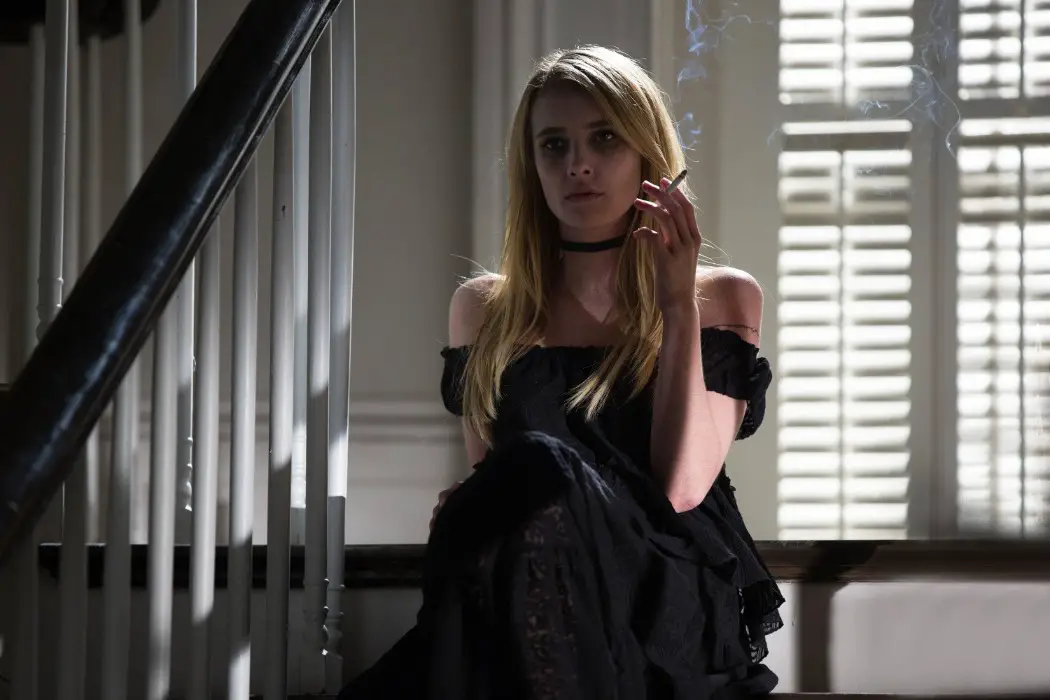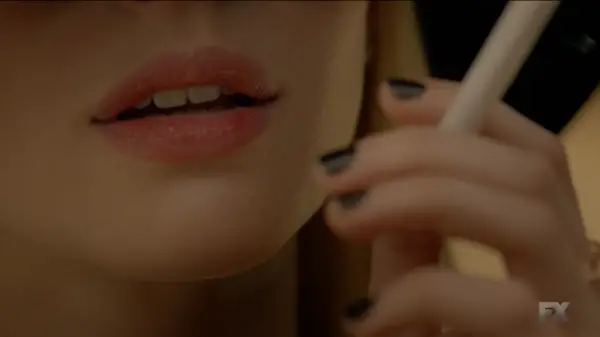AMERICAN HORROR STORY’s Madison Montgomery: It Girl, Witch Girl, Holy Girl

Michael Colbert is a writer based in Portland, Maine. He…
The third coming of Madison Montgomery has been foretold by meme culture: we thought we’d seen the last of her and now here she is. In American Horror Story: Coven, Madison (Emma Roberts) is the Hollywood child star for whom witch school feels a bit like rehab. She’s self-reliant and self-interested. She gets called a stone-cold bitch more than once and dies twice.
In Apocalypse, she gets a third chance at life, brought back from hell by Michael Langdon, Antichrist Apparent, as a testament of his power.
The Curated Life of Madison Montgomery
Madison curates a strong persona, but it’s curated. In the end, she’s a receptacle for everybody else’s desire and gaze. In the first episode of Coven, she’s drugged at a party by frat guys, locked in a room, and graphically gang-raped when they realize who she is. When they try to flee the scene, she flips their bus with her telekinesis. After the assault, she’s outwardly strong and resolute among the other witches of the coven, but shots of her alone show her holding her body and sobbing in the bathtub.
Fiona (Jessica Lange) perpetrates violence against Madison as well. As the coven’s leader, the Supreme, she’s responsible for identifying her successor. She takes Madison under her wing only to slit her throat and hide the body. Fiona sees a younger version of herself in Madison’s brashness, in the way she gets attention from men at the bar, and she’s pushed to murder Madison in order to protect her own power and remove the threat to herself. Early on, Madison becomes a figure of anxiety for the coven: she’s such a strong presence and is ultimately silenced for how she sticks her head up.

Once she’s been killed, Madison missing becomes a key plot point. The other witches try to find her, to hear her voice in the spirit world. They eventually recover the body from the live-in butler in the attic–who dresses her decaying corpse like a doll–necrophilia meets Lolita–and bring her back to life.
In her second coming, we hear from her about the trauma of dying, the darkness and lack of anything on the other side. She begins to act of her own desires, finding feeling again when she has sex with Kyle (Evan Peters) who she killed in the frat bus and who she brought back from the dead as a Franken-boy. She shares him with Zoe (Taissa Farmiga), and we see Madison working her way through the coven, her powers growing, her ascendance one we maybe love to love or love to hate. In the season finale, she seems most likely to become next Supreme until she fails the last test. When she refuses to bring Zoe back from the dead, Kyle strangles her on the bed as she prepares to run away.
New End of the World, New Me
When the witches come back in Apocalypse, Madison is among the first three to appear on screen. She quotes herself–and meme culture–to announce her return in a nod to how people have awaited her return. She bets we thought we’d seen the last of her, though maybe we hoped we hadn’t.
Apocalypse fascinatingly plays with the gaze on Madison. In season three she often operated within gaze, pushed to act a certain way to protect her own persona and to assert her ascendance to Supreme. Madison was a receptacle for our desires. Every day, she wore something hugely different; Victorian gown one day, black funereal gown the next, mini skirts and crop tops and leather jackets. Every time you looked, she’d changed and invented for herself something new. Every time she got called a stone-cold bitch, it felt a bit like slut shaming, and shots of her crying alone or competing with Zoe for Kyle in the finale captured both the trauma she was processing and the jealousy within her. In a speech about being a millennial, she speaks of the numbness inside of her, and the show manages to create sympathy for her, avoiding characterizing her solely as the bitch that others see in her.
In Apocalypse though, her image has stabilized: others begin to perceive in her the softness and complexity we’ve seen all along. The other characters’ gaze is less judgmental. Perhaps it’s the years she spent in hell that have made her change her outward image. Though her costumes follow consistent lines (black and edgy) the filming of her more clearly acknowledges the sutures. In her essay “Suture,” Kaja Silverman outlines the ways women are cut up in film. Long legs here, breasts there, a close-up of her eyes in another shot. Whereas men get to appear fully formed, women exist as their component parts – which in horror film they oftentimes get cut up into.
Season eight sutures Madison on screen. When the show provides backstory on her return from the dead again and she goes to meet the coven, we see her fingers with black nail polish draw a cigarette to her mouth. When she steps out of a car, her boots and fishnets announce her arrival. Madison is cut up for our desire like the Black Dahlia in the basement of Murder House. You have to do anything to be famous, she says.

The camera often cuts up Madison the way that the show has cut up Emma Roberts from one season to the next. Every time she’s appeared in the show and died, it’s at the hands of passionate, deranged killers. In Coven, her throat is slit and later hands on her throat strangle her. In Freak Show, she’s locked in a box and sawed in half. Cult shows her as a newscaster disemboweled by demonic clowns. Though Roberts is a favorite of Murphy and Falchuck, between Horror Story and Scream Queens, she’s also a favorite to be sutured to death.
The filming of Madison seems to acknowledge this. And the narrative simultaneously recognizes it and pivots. Madison returns to Murder House from season one in order to learn more about Michael Langdon’s past. When she encounters the ghosts here, Madison has great restorative powers. As a survivor, both of death and sexual violence, she hears their stories of trauma and gives them space to heal. She digs up Moira’s bones and buries her with her mother so she can be freed. She gives Violet some words (and fairy dust) to allow her to reconcile her love for Tate. Her companion in the house continually calls her a softie, and Madison acknowledges how she seeks to use her third chance at life well.
At a moment like this in the US, when survivors are silenced and denied the right to be heard, Madison announces her solidarity and listens. She even says she’d bury her bones in Paramount Studios to haunt the men who made her film nude scenes and denied her a body double. In Coven, she said that it was her destiny to die, come back, and ascend to the Supreme like our lord Jesus Christ. And in her third coming, it seems that’s what she’s poised to do.
Does content like this matter to you?
Become a Member and support film journalism. Unlock access to all of Film Inquiry`s great articles. Join a community of like-minded readers who are passionate about cinema - get access to our private members Network, give back to independent filmmakers, and more.
Michael Colbert is a writer based in Portland, Maine. He loves horror film (his favorites are Candyman and Rosemary's Baby), and he’s a coffee addict (his favorites are Costa Rican and Ethiopian). His work has appeared in Avidly, Maine the Way, and Germinal.












